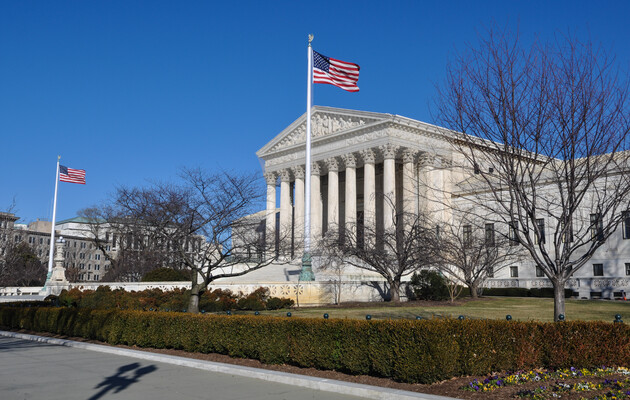Reform of the US Supreme Court. Workshop from President Biden
article by Dr. Sergii Koziakov, Associate Professor, Institute of International Relations at Taras Shevchenko National University of Kyiv, Visiting Senior Fellow, Law School, London School of Economics
The Supreme Court of the United States of America, founded in 1789, is included in the list of the most prominent institutions of judicial power throughout the world, standing out among others thanks to its captivating features. The court is the highest judicial authority in the country dealing with all cases and controversies with the Constitution or laws of the United States.
There are at least three grounds for general respect for the US Supreme Court:
- Firstly, there is a long history of reliable and effective judicial review in upholding the protection of democracy, the separation of powers, the rule of law, and individual rights.
- Secondly, the quality of his conclusions is outstanding.
- Thirdly, one can’t help admiring the transparency of the work and the degree of awareness and general support of the US public for the work of the Court.
Few other courts in the world have the same powers to interpret the Constitution, and none has used them for so long or with so much influence. Therefore, the event to be discussed below, did shock the American community and lawyers around the world.
Despite the popular opinion that nothing better than the US Supreme Court has been invented in the world, in the spring of 2021 US President Biden initiated a professional discussion about the feasibility of its reform. On April 9, 2021, Decree No. 14023 on the Establishment of the Presidential Commission on the Supreme Court of the United States was issued, on the basis of which a commission was created from a bipartisan group of experts consisting of 34 people.
Why did incumbent President Biden initiate a professional discussion about the feasibility of reforming the Supreme Court? Is everything really as cloudless in the US justice system, as it is believed to be? What will this initiative lead to, and what can affect the decision of the presidential commission, which will make it public on December 14? And why, in fact, should we, the reformers of our judicial system, get acquainted with the experience of the Americans?
A glimpse into the system from the inside
Unlike in Ukraine, where judges are appointed indefinitely, but work no longer than until they reach the age of 65, in the United States, appointed Supreme Court judges administer justice for life. Record holder William Douglas worked as an associate justice for 36 years and 211 days before retiring. Her Honor, Ruth Ginsburg, also served a long time of 27 years and 39 days, vacating the office due to death.
Most cases are heard in courts located on the territory of the states. Only the most significant cases reach the Supreme Court. Initially, the Supreme Court consisted of six judges; later, the number of judges was increased. Now there are nine judges.
Back in the 1980s, the Court considered about 150 cases a year. In the most recent reporting period of 2020–2021, the nine justices of the US Supreme Court heard 64 cases. By comparison, only the Grand Chamber of the Supreme Court of Ukraine consisting of 21 judges in 2020 considered 1,013 cases (on average, 48 cases for only one judge); the entire Supreme Court of Ukraine considered in total 93,583 cases.
The President of the United States appoints Supreme Court justices based on such factors as merit, record, and political affiliation. The appointment process is deeply politicized, and judges are often labeled as “liberal” or “conservative.” Judges appointed by the president are agreed upon based on the results of hearings at the Senate.
A huge number of media outlets, scholars (not exclusively lawyers), bloggers, and ordinary citizens closely monitor the activities of judges and their individual decisions on a daily basis. Along with the recognition of undeniable historical merits to the American people, the Supreme Court and individual justices are subjected to merciless criticism. For instance, many in the USA consider the politicization of the modern US Supreme Court to be a “danger to democracy.”
This can apply, for example, to the head of the Supreme Court. “A troubling and unmistakable trend has developed over several decades, and accelerated in recent years, of extreme judicial activism within the conservative bloc of Justices on the Supreme Court – reaching a new pinnacle under Chief Justice John Roberts.”
Judges of the US Supreme Court are also criticized for dishonesty and lack of transparency in their work. This also applies to the appointment procedure. Horror fans should watch the tape of the interrogation, during which candidate Brett Kavanaugh (now a current Supreme Court justice) is turning pale, drinking water, and with a pitiful look answering questions mercilessly and coldly asked by Senator Kamala Harris (now the vice president of the United States).
By the way, in the public information space of the USA, unprofessional criticism of Supreme Court judges with nervous undertones is considered bad tone. This applies, inter alia, to cases when it is resorted to by high-ranking state officials.
In November 2018, President Trump, angered by a federal district court ruling that contradicted his administration’s attempt to block migrants from seeking asylum at the border, called Judge John Teagar a biased “Obama judge.” Defending the integrity of the federal judiciary, Chief Justice John Roberts Jr. presented an unusual response, to say the least, although he did not name Trump. “We do not have Obama judges or Trump judges, Bush judges or Clinton judges,” he said in a statement. “What we have is an extraordinary group of dedicated judges doing their level best to do equal right to those appearing before them. That independent judiciary is something we should all be thankful for.”
During the more than 230-year history of the Supreme Court, attempts to reform it have been made several times. Each time, despite the politicization, these attempts were very careful and with the aim of maintaining the stability of this extremely important institution of state power.
Biden’s initiative
The commission was created under pressure from a growing chorus of critics, particularly outraged by the tactics used by Republicans in appointing the last three justices, while simultaneously calling for an increase in the number of judges on the Court. In short, the commission was created not at all to develop a plan for the implementation of the already adopted decision and not even to prepare a draft law, but to check the arguments “for” and “against” the reform of the Supreme Court.
This kind of experience is important for the Ukrainian reformist pool, when the drivers of the reform (as well as often those who are disguised as pseudo-reformist activity for the realization of completely different goals) first make an unprepared radical decision, and then heroically reap its benefits. This was the case after the 2019 presidential and parliamentary elections, when, as part of the judicial reform initiated by the first-wave reformers in “crazy printer” conditions the Verkhovna Rada passed a law on terminating the powers of the High Qualification Commission of Judges of Ukraine. We have already written several times about what this has led to. I am glad that the attempt to halve (!) the number of judges of the Supreme Court in Ukraine was unsuccessful. It is necessary to mention the colossal burden on judges. Not to mention the dangerous shaking of the entire state mechanism.
How it started in the US
The vast majority of the members of the Commission are professors at the legendary law schools of the universities of Harvard, Cambridge, Yale, Berkeley, Princeton, Columbia, New York, Chicago, and others, having significant scientific and practical biography. In addition to legal scholars (mainly constitutionalists) and other experts, the Commission includes retired federal judges and practitioners with experience and knowledge of the Federal Judicial System, as well as sympathizers of the reform of democratic institutions and the administration of justice. However, these members of the Commission have considerable academic experience.
The decree sets exclusively specific tasks consisting in analyzing the main arguments of the modern public debate “for” and “against” the reform of the Supreme Court, namely:
- report on current commentary and debate relating to the role and operation of the Supreme Court in the US constitutional system and the operation of the constitutional process within which the President nominates candidates and, upon the recommendation and consent of the Senate, appoints justices to the Supreme Court;
- the historical background of other periods in the country’s history, when the role of the Supreme Court, as well as the process of nominating and approving candidates for the post of judge, were critically evaluated – and prompted the emergence of reform proposals;
- analysis of the main arguments in the contemporary public debate “for” and “against” the reform of the Supreme Court, including assessment of the merits and legality of specific reform proposals.
Topics pertaining to length of work and change of judges in the Court; membership and size of the Court; selection of cases, rules, and practice of the Court were also proposed for discussion.

In order to discipline professors, who make up the majority of the Commission and often fail to notice the passage of time, the decree mandated that the Commission complete its report within 180 days of its first open meeting.
From May to November, the Commission held five open meetings and managed to develop a number of procedural and meaningfully analytical materials. All materials, as well as the decisions made by the Commission, are published, and the meetings are broadcast on the Internet.
The commission approved four areas of work.
The first line of research laid the foundation for the work of the Commission and was called “Genesis of the Debate on Reform.” In this direction, for example, they discussed what problems, if any, the reform of the Court should be devoted to?
The second direction was the study of the role of the Supreme Court in the constitutional system. For this purpose, the Commission decided to analyze the debate about the scope of the Court’s powers and, more generally, about the Court’s powers to invalidate acts of other branches of government. The commission was tasked with assessing how proposals to reform the scope of powers would potentially affect the Court’s role in relation to other branches of government (essentially the separation of powers) and to consider the implications of proposals affecting the scope of the Court’s powers.
Working on the third direction, the Commission determined the length of service and changeability of justices at the Court. The commission analyzed the terms of work of judges in office and the periodicity of changes in the composition of the Court, including proposals to limit the term of their powers and mandatory resignation.
The fourth task was the consideration of the proposals on the quantitative composition of the Supreme Court. Not only the proposals on the quantitative composition were considered, but also the strong and weak aspects of the proposals. At the same time, proposals received in other periods of the history of the US were also considered, as well as the consequences of a possible increase in the number of current judges.
In connection with this list, the remark made during the first meeting by Kate Andreas, member of the Commission and professor of law at the Faculty of Law of Columbia University, deserves special attention. “As we consider these various issues raised by public comment, we will engage in historical research, conduct comparative analysis, and consider parallel issues within state judicial systems. We will consider whether reform would require legislation, constitution amendment, or reinterpretation of the doctrine, or would otherwise raise legal concerns.”
The materials of the meetings of the Biden Commission dated May 19, June 30, July 20, October 15, and November 19 are worth studying by those Ukrainians who professionally (and being eager to be responsible and truly professional) deals with justice reform. Why? To know how problems in justice are really determined, how they should be analyzed and how to make decisions, even when they will be unpopular not only among trained professionals, but also among residents of our deep province poisoned by the TV.
Opinions worth considering
Harvard University Associate Professor Nikolas Bowie argued in earlier remarks, for example, that the Supreme Court is an anti-democratic institution empowered through judicial review to overrule federal laws by simple majority vote. He emphasized that the question is not whether the Constitution should be upheld, but what it means when the president, more than 500 members of Congress, and four justices of the Court interpret the Constitution to allow a particular law, yet five judges of the Court disagree and consider this law unconstitutional.
Harvard University professor Noah Feldman said that weakening the Supreme Court by changing its constitutional jurisdiction or the number of seats would undermine its institutional legitimacy, thereby reducing its ability to perform its core functions. Finally, Professor Feldman warned that other US institutions are likely ill-suited to carry out the main functions of the Supreme Court.
Stanford University professor McConnell called on the commission to seize a historic opportunity to reaffirm the principle of judicial independence that is central to the U.S. constitutional system, and to use its platform to explore ways to reduce partisan tensions in the Supreme Court nomination process. Professor McConnell argued that any move to expand the Court would threaten the independence of the judiciary and further undermine the nomination process. Professor McConnell warned that while Congress can, under the Constitution, increase the number of Supreme Court justices as it was previously done, many members of the public are likely to view the expansion as an illegal attempt to influence the decisions of the Supreme Court, effectively turning it into the tool of the legislative power.
For the meetings of the Commission, 27 speakers prepared talking points expressing their views on all topics of the Commission’s work – 513 pages in total. The Commission also received 552 pages of legal comments from 23 law professors and public organizations. The e-mail of the commission received about 2,600 comments, mostly from interested citizens. All texts have been published.
Based on the results of the processing of the above-mentioned materials, final drafts (about 200 pages) of papers of the Commission itself were presented to the meeting on October 15. For the lazy part of Ukrainian reformers, this part of the materials will be the most interesting.
Even a brief summary of talking points of the participants in rather passionate and merciless discussions during the Commission’s meetings shows the presence of sometimes directly opposite views in the American legal beau monde on the current role and place of the Supreme Court.
These materials attempt to outline the broad range of points advanced during the public debate on US Supreme Court reform. They were designed to ensure a comprehensive discussion of these points and to assist the Commission in its so-called vigorous and wide-ranging deliberations.
The representatives of the Commission emphasized that the inclusion of specific points in these draft materials does not mean the Commission’s approval or rejection of any of them, and specific points of analysis or specific points of view contained in the drafts should not be understood as reflecting the point of view of the Commission as a whole or any particular commissioner. The Commission insisted that, in accordance with Decree No. 14023, it included specialists with different views on these issues.
The work of the Commission was delayed for about a month. Meanwhile, it encountered criticism from both the right and the left. Two Conservative members resigned last month.
The commission will meet again on December 7 for its final meeting, where it will consider the revised draft of the report and vote on its submission to the president.
A concerned professional observer shall for now familiarize himself/herself with the materials of the Biden Commission and wait for the texts of the Commission’s final documents to be made public in December. Why? To learn about the experience of preparing state decisions, the implementation of which over tens and even hundreds of years allows us to consider, for instance, that the Supreme Court of the United States is the best state institution invented by mankind.
By the way, the Biden Commission can also make a decision, the leitmotif of which will be to prematurely reform the US Supreme Court.
In any reform, both the opinion of its drivers since they really will not allow speed to be lost, and the position of people from the system who know how it works and are able to calculate the risks is equally important. Unfortunately, in Ukraine, those still willing to stamp government decisions in the “crazy printer” mode do not particularly burden themselves with such useful information. Reformers of the second wave can tell how to correct their mistakes and miscalculations under the conditions of lost time. Only they don’t have time for telling stories anymore. At all.
English version of this this Article has been prepared with support to Cara’s Fellowship Programme.
Any views or information included within the publication are entirely owned by the Author.
Read this article in russian and Ukrainian at the links.
Please select it with the mouse and press Ctrl+Enter or Submit a bug












.jpg)


 Login with Google
Login with Google